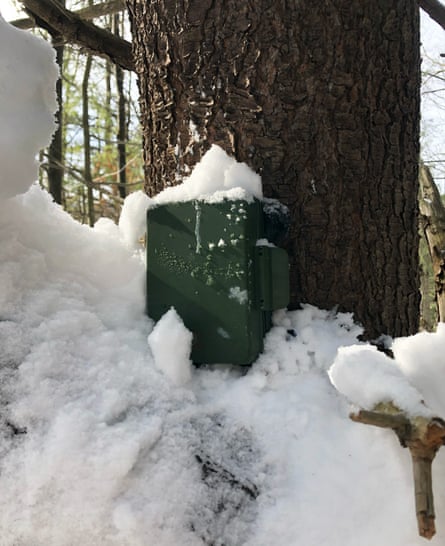What does a landscape sound like when it’s not being listened to? This philosophical question was a catalyst for film-maker and artist Joshua Bonnetta, who has distilled a year of recordings from a single tree in upstate New York – that’s 8,760 hours – into a four-hour album, The Pines. As Robert Macfarlane writes in his accompanying essay, The Pines is a reminder of the natural world’s “sheer, miraculous busyness”, its “froth of signals and noise”. It is rich with poetic meaning, and resonant amid the climate emergency.
“It started as a personal thing,” Bonnetta explains from his studio in Munich, where he relocated from the US in 2022. For over 20 years he has made sonic records of places as private mementos, but recent experiments with long-form field recording led him to push himself “to document this place in the deepest way I could”. On a residency in the Outer Hebrides between 2017 and 2019, Bonnetta made the sound installation Brackish, a month-long continuous radio broadcast from a weather-resistant hydrophone – an underwater mic – by a loch. “I started to leave the recorder for a day or two, then it just got longer,” he says. “Amazing things happen when you’re not there to interfere … This allows you a different, very privileged window into the space.”
Back in Ithaca, New York: “Sometimes I’d be in the woods at night with friends and we would hear owls or coyotes – but it would be rare and fleeting,” he says. He decided to use his Hebrides technique to document nearby Tioga County, and strapped a recording device 10ft up a pine tree. He returned every few weeks to replace batteries and storage cards, and sometimes the fluffy mic covers that “chipmunks got obsessed with” on his otherwise hardy equipment.
Bonnetta recorded his 8,760 hours of audio from May 2021 to April 2022. He approached the intimidating editing task with the help of Holger Klinck, an expert in conservation bioacoustics at Cornell University, who showed him how to identify sounds graphically with spectral analysis software. “I’m in awe of scientists,” says Bonnetta, who frequently collaborates with them.
Then his friend Josh Berger, a re-recording mixer who has worked with Oliver Stone and Steven Soderbergh, introduced him to a program he describes as “Photoshop for sound – he uses it to clean sound up, but it can also be used to dismantle and put it back together.” The editing process took three years between other jobs. “I would come home after work like, ‘OK, I’m gonna work on the tree,’” he says.
Bonnetta describes The Pines as a “spectral collage”. Its four hours are not edited highlights but layered constructions, like a poetic version of a scientific chart. “When I pieced sound together, I would multi-track,” he explains. “So maybe you’re listening to the rain falling, but that’s all the rain in July.” The result gives an impressionistic idea of the life-cycles of crickets and frogs as their sounds enter and exit, but also offers up changing sounds of the trees themselves, as branches creak under snowfall and crack with growth. “You can almost hear leaves fill in on the deciduous trees,” he says, linking his palpable sense of wonder back to an early memory of a schoolfriend sharing what they claimed was a recording of wolves. “That’s what it reminded me of when I worked on it: listening in the dark, anticipating what’s going to come next.”
As with any recording of the natural world, The Pines comes with an undercurrent of mourning. It isn’t explicitly about the climate crisis, but Bonnetta admits that his practice is coloured by its threats. “You could always be recording something that you might not be able to record again,” he says, recalling audio he made in his old Ontario neighbourhood. “A huge highway was about to be built through it, which would change the acoustic ecology drastically because the natural soundscape would be removed.”
Next, Bonnetta is documenting the inner geological sounds of the Alps. “One mountain has little earthquakes every time there’s heavy rainfall,” he says of Mount Hochstaufen, where scientists are investigating a phenomenon that has been occurring for centuries. There’ll also be an audiovisual portrait of the Bavarian forest at night, a film documenting the work of bioacoustic scientists on Rapa Nui (Easter Island), and he is fascinated with the sounds of Munich, his new city. “I’ve never lived in Europe before, where you can hear bells from all the different neighbourhoods and sense the distance,” he says. “It’s really beautiful to have that sense of space through local sounds.”
There is a generosity in Bonnetta’s work; its offer of time to spend within a landscape, which gets infused with personal meaning. But heed his warning before listening to The Pines: “Just don’t fall asleep,” he says, because “there’s some pretty gnarly raccoon!”









